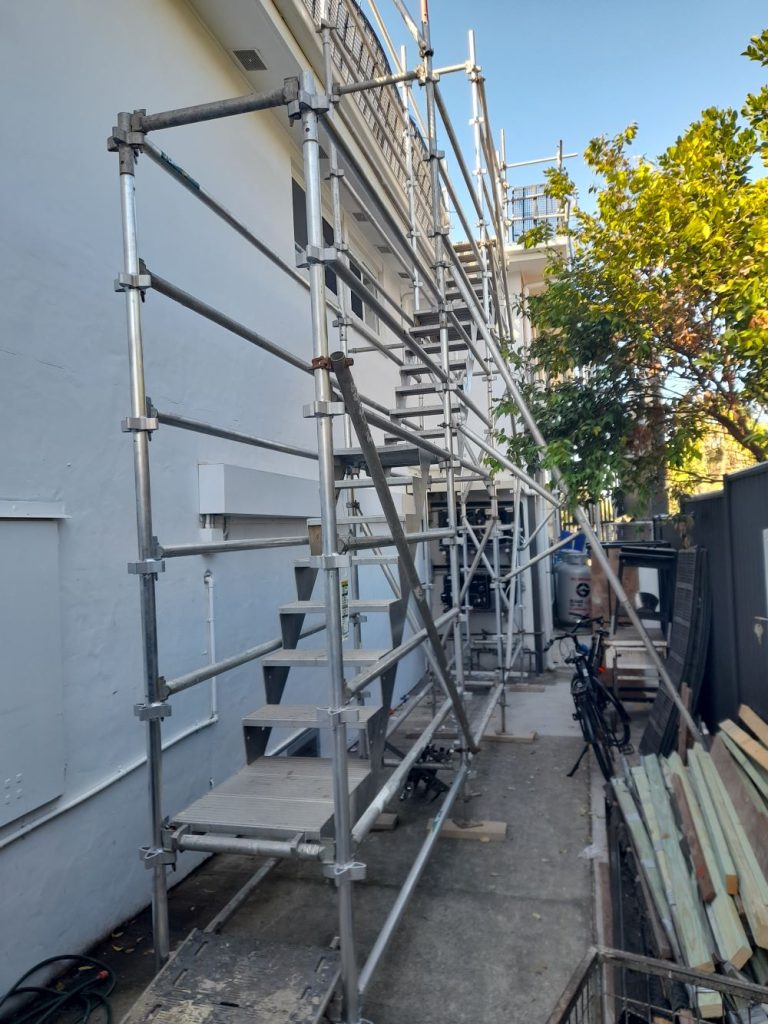If you have ever engaged in the use of scaffolding, you may have considered the practicality of placing a ladder on top of it to access elevated areas. While this might seem like a straightforward and convenient solution, it is crucial to carefully evaluate the significant safety concerns that arise before proceeding with this approach. A comprehensive understanding of the inherent risks and adherence to relevant regulations is essential to ensure not only your safety but also that of your colleagues and bystanders in the workspace.
Although it might appear to be a simple task, using a ladder on scaffolding is EXTREMELY hazardous. The addition of ANY extraneous items onto a well-structured scaffolding framework can introduce serious risks. The dangers associated with this practice are substantial and should never be underestimated or dismissed. Prioritising safety above convenience in any construction setting is absolutely vital.
This article aims to explore the various reasons why placing a ladder on scaffolding is inadvisable, shedding light on the potential hazards involved and discussing safer alternatives that should be considered in such scenarios.

Thoroughly Evaluating the Safety Hazards of Ladder Usage on Scaffolding
The unambiguous answer is NO; using a ladder on scaffolding is NOT considered safe.
Incorporating a ladder onto scaffolding introduces considerable dangers that can compromise the integrity and safety of the entire assembly. The primary function of scaffolding is to provide a secure, stable working platform that adheres to rigorous load-bearing specifications. When a ladder or any other equipment is placed on this structure, it can disturb the balance of the entire system, thereby escalating the risk of accidents, falls, and potentially severe injuries. Hence, while it may seem like an efficient shortcut to reach a higher area, the associated hazards overwhelmingly surpass any perceived advantages.
Also Read: What NOT to Do When Using Scaffolding for Safety
Identifying the Specific Risks Associated with Ladder Usage on Scaffolding
Having established that using a ladder on scaffolding is unsafe, let’s delve deeper into the specific dangers that accompany this practice:
1. Diminished Stability of the Scaffolding Structure
Scaffolding is meticulously designed as a robust and safe working platform; however, the addition of a ladder can significantly disrupt this equilibrium. Ladders are engineered to be placed on solid ground rather than atop another structure. When positioned on scaffolding, a ladder can destabilise the entire setup, significantly increasing the risk of falls, slips, or even a complete collapse of the scaffold. This precarious scenario poses a serious threat not only to the user but also to everyone in the vicinity.
2. Height Elevation Intensifies Fall Risks
When operating on scaffolding, you are inherently positioned above the ground level. Adding a ladder can further escalate this height, thereby amplifying the fall risk exponentially. The instability introduced by the ladder on scaffolding can create hazardous situations, especially if the ladder shifts, slips, or fails to maintain adequate stability. The likelihood of sustaining severe injuries increases dramatically with falls from greater heights, making this practice exceptionally perilous.
Also Read: Who Is Responsible for Scaffold Hire and Safety?
3. Incorrect Ladder Angle Significantly Heightens Accident Risk
Ladders are designed for use at specific angles to ensure safety during operation. Placing a ladder improperly atop scaffolding prevents achieving the correct angle essential for stability. An incorrectly positioned ladder is susceptible to slipping or sliding, particularly when placed on a surface that lacks firmness and support. Furthermore, scaffolding does not offer the same level of stability as a solid ground surface, making it challenging to secure the ladder at the appropriate angle, thereby exacerbating the risk of accidents.
4. Inadequate Securing Leads to Serious Hazards
Using a ladder on scaffolding often results in insufficient securing of the ladder itself. Most scaffolding setups are not designed to accommodate ladders, leading to a lack of reliable methods to secure them properly. Although the ladder may seem stable at first glance, any movement, vibrations, or slips can quickly result in the ladder tipping over or falling, posing a significant risk to users and those nearby.
5. Violating OSHA Safety Regulations
When working on a construction site, compliance with safety regulations is often mandated. The Occupational Safety and Health Administration (OSHA) enforces stringent guidelines regarding the safe utilisation of scaffolding and ladders. Misusing a ladder on scaffolding can lead to violations of OSHA standards (such as 1926.1053 for ladders and 1926.451 for scaffolds). Non-compliance may result in legal repercussions, fines, penalties, or even project shutdowns, making it critical to adhere to safety guidelines diligently.
6. Risk of Certification Revocation Due to Unsafe Practices
Every scaffolding installation undergoes a rigorous certification process to verify its safety for use. Altering that setup by incorporating a ladder compromises its certified status. In the event of an incident, you may find yourself unprotected regarding work health and safety regulations. Without valid certification, you assume significant risk, which is an unacceptable gamble that could lead to serious consequences.
Exploring Safer Alternatives for Accessing Elevated Areas
Now that we have comprehensively examined the reasons against using a ladder on scaffolding, let’s explore safer alternatives for reaching your desired height without compromising safety or contravening regulations:
Utilise Built-In Scaffold Access Solutions for Enhanced Safety
Most scaffolding installations come equipped with built-in access features, such as ladders or stairways. These access points are specifically designed to ensure safety while navigating up and down the scaffolding. If your scaffolding includes these built-in access options, it is essential to take full advantage of them! They are engineered to work in harmony with the scaffolding system, significantly enhancing overall security and minimising the potential for accidents.

Consider Work Platforms or Extensions for Safer Access to Heights
Another viable option is to employ a work platform or an extension. These solutions are specifically designed to provide a stable surface for working while granting safe access to higher levels. They represent a more secure alternative compared to attempting to balance a ladder on scaffolding. Work platforms are sturdy and certified for use with scaffolding, ensuring your safety while facilitating the efficient and effective completion of tasks at elevated heights.
Essential Insights on the Use of Ladders with Scaffolding
So, can you safely place a ladder on scaffolding?
The unequivocal answer is no! Using a ladder on scaffolding can lead to structural instability, heightened fall risks, and violations of critical safety regulations. The potential consequences simply do not justify the associated risks. Instead, take advantage of built-in scaffold access methods or opt for safer alternatives, such as work platforms. Always prioritise safety; the last thing you want is to jeopardise your well-being or that of others for convenience. Adhering to proper guidelines will ensure that you remain safe and compliant while on the job.
The Article: Ladder Safety on Scaffolding: What You Need to Know first appeared on https://writebuff.com
The Article Ladder Safety Tips for Scaffolding You Must Know Was Found On https://limitsofstrategy.com

